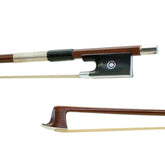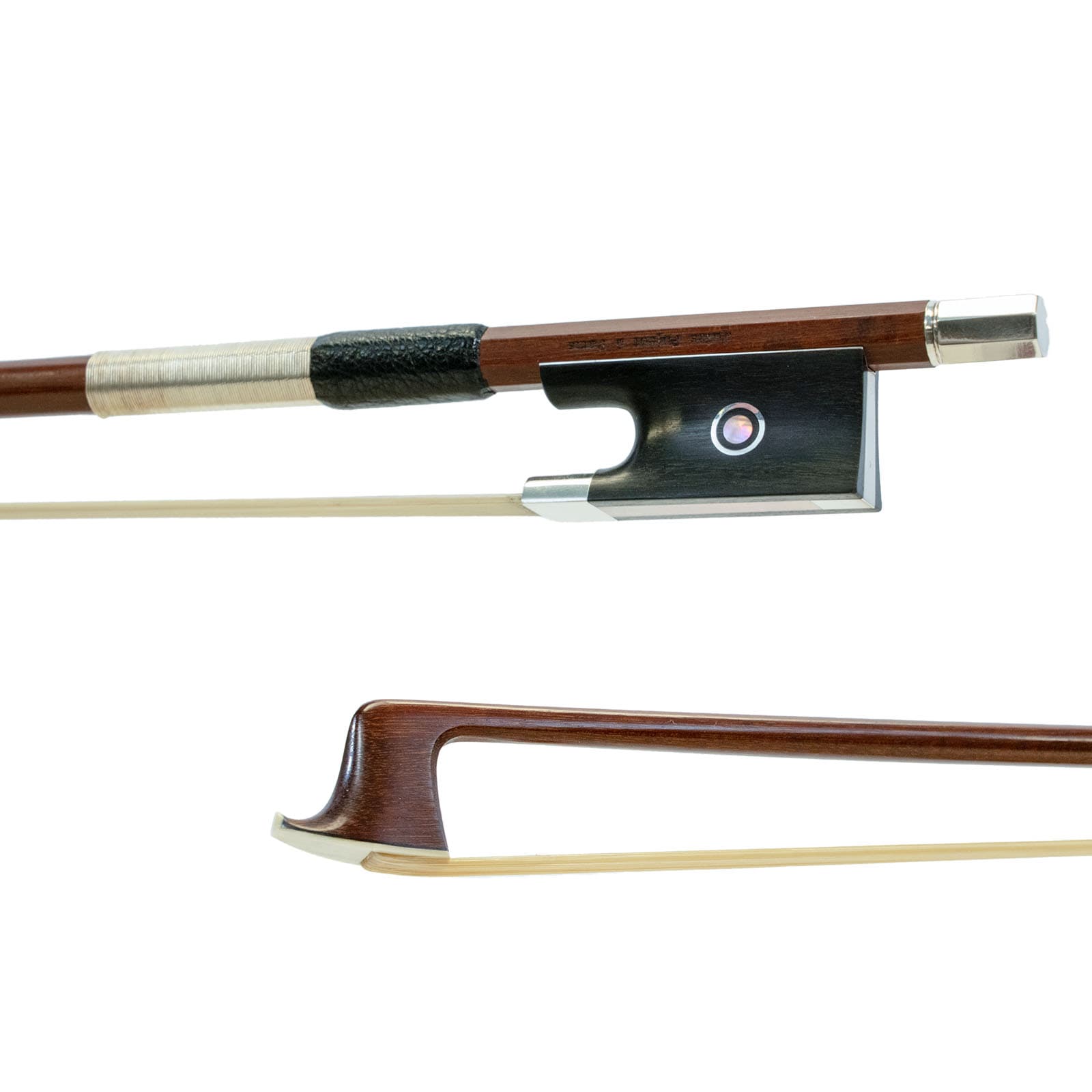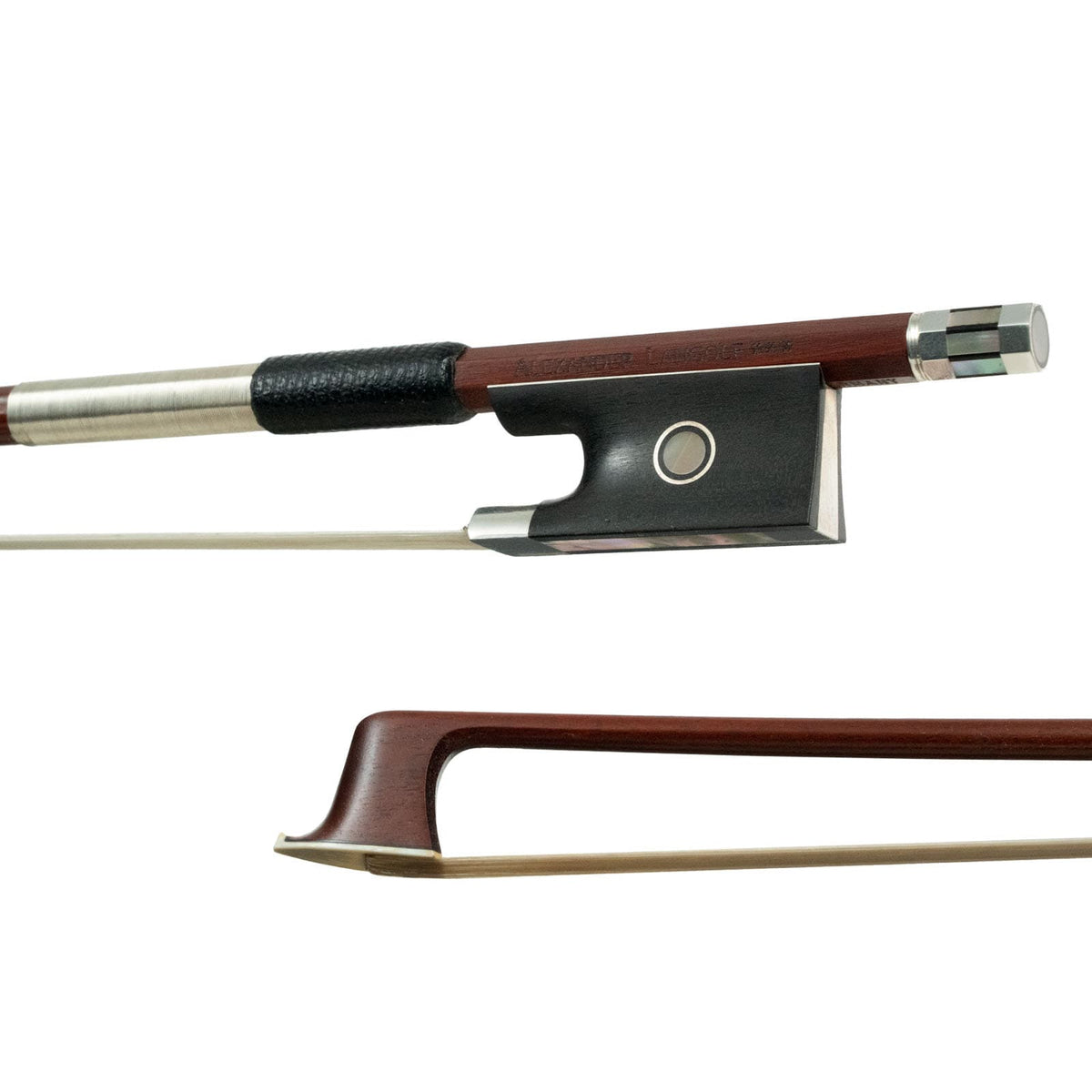REVIEW VIDEOS
The Soul of a Great Bow
The majority of fine bow makers since the time of Francois Tourte have been French. The Jules Pajeot à Paris bow, completely handcrafted in France by a noted atelier, is a presentation exclusively from Shar which begins with pernambuco aged for over 75 years, each shaft tested for strength and flexibility. The addition of fine Ebony and sterling Silver to produce a beautiful and durable frog and button completes each bow before its final branding- Jules Pajeot à Paris . A synthetic head plate assures easy passage through Customs and Borders inspections.
Great wood and great workmanship are the keys to the creation of a great bow. The Jules Pajeot bow is hand made from Louis Bazin's aged stock of superb pernambuco wood, dating to the early 20th century. Strong yet flexible -- the mark of the great masters of France -- the Jules Pajeot à Paris model is favorably compared to bows costing upwards of $10,000. For the artist seeking a bow that is up to the most extreme technical demands in the repertoire: This is a bow possessing the strength to open the Brahms concerto with the flexibility needed to perform the variations of Tartini's Art of the Bow. A certificate accompanies each bow sold.
Why French Bows? A Brief History
Until the ascent of the violin in solo literature and more intricate music, the bow was a mere accessory, for the simple reason that music did not pose the kind of technical challenges that came later. Although the sound of the violin necessarily originates with the bow, the simpler (or less variant) musical and technical demands of long ago required a simpler bow than today's bow. With the violin mainly in the background, and often simply accompanying dance, that was enough. Just as with the development of the violin, the development of the bow, as with any musical instrument or "tool of the trade" is linked to the needs of the player. And the player's needs are directly linked to the demands of the music as envisioned by the composer and audiences.
Today's violin originates from the baroque era, which reached its pinnacle with the great Italian makers of Amati, Stradivari, Guarneri and others. As music evolved into its more complex forms during late 18th and early 19th century, new techniques of playing and teaching were in great demand. The French violinist, composer and teacher, Giovanni Battista Viotti, was at the forefront of this new style of playing, placing radical new demands on the violinist . . . and the violin. The great Italian violins of the baroque era were thus greatly modified, refitted with new necks at more severe angles, longer fingerboards, and even higher tuning, to support these quickly evolving demands. Indeed, every violin from the baroque and classical era that is still being used today has undergone these drastic alterations.
It was during this same time that the simple bow from the baroque era evolved rapidly into the bow that is familiar today. And these changes happened in France. Today, we call this "disruptive innovation". In late 18th century France, the disruptor was François Xavier Tourte. Tourte enjoyed great success in his lifetime. His early career as a watchmaker helped him develop great coordination and attention to detail. His sensitivity to the needs of musicians during this period of rapidly evolving music impelled him first to perfect the classical bow of the time, then to change it to serve his musician customers. His list of innovations in the development of the bow is vast: He was the first to use pernambuco wood, which has the natural qualities of strength and flexibility that enabled a number of important changes – a narrowing of the stick to create agility; reversing of the arch, to provide power and fast response; widening of the frog and ferrule to accept a wider ribbon of hair, for yet more power. The new bow wrought by Tourte's hands enabled new techniques of playing to emerge: sautillé, saltando, spicatto, as well as stronger legato and cantabile playing. Violinists exploited these new advantages, allowing them to play as never before, quickly moving the violin into its prominent place as the solo instrument of Paganini and other virtuosos of the day.
Interestingly, if Tourte was not satisfied with a bow that he made, he would simply destroy it, not sell it at a discount. And he did not work with assistants or apprentices, jealously guarding his secrets. It took the great Jean-Baptiste Vuillaume to "deconstruct" that which Tourte had created, much as he did with the great Italian violins of the 17th and 18th centuries. Vuillaume's genius enabled him to discover the technical and physical qualities inherent in Tourte's bows, largely because of Tourte's intuition and trial and error methods. Ever the astute businessman, Vuillaume was able to systematize what he learned, successfully applying Tourte's discoveries and innovations in his vaunted Mirecourt workshop. His now-legendary makers, Voirin, Peccatte, Maline, Simon, Sartory, and others, used these discoveries in the crafting of the great bows revered by today's great artists of the violin.
The Bazin Legacy
With the auspicious name of François Xavier Bazin, the Bazin dynasty began in Mirecourt and continued through four generations of bow makers, until 1987. François Xavier studied bow making with the best: Vuillaume and Peccatte. Opening his own firm in 1840, Bazin's workshop employed great bow makers: Fetique, Ouchard, Vatelot, among others. The firm was represented over its 147 years by Bazin's brothers, sons, grandsons and great grandsons. Charles Louis Bazin was the last in this line, operating the firm until it closed in 1987. Trained as a bowmaker, Charles Louis found his stride as a respected merchant and promoter of both his firm and Mirecourt in general. He worked tirelessly to raise the professional status of bow makers from workers to artisans. Bazin sold his carefully selected supply of fine, aged pernambuco when he closed his shop, much to the benefit of a lucky few bow makers today.
This item comes with Shar's 1 year warranty covering defects of workmanship or materials. General wear and tear or mis-use are not covered. Non-transferable.
30-Day No Hassle Return Policy
If you are not satisfied with this item for any reason you may return it for a full refund within 30 days of purchase.
If you have any questions about this product's warranty or to make a return please contact our Customer Service Department at 800.793.4334 or email us at cc@sharmusic.com











